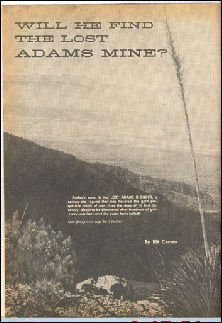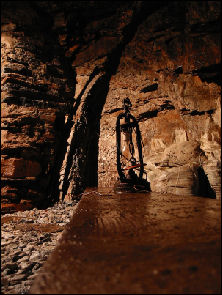Main Listing Page
The Lost Adams Mine
One of the most fantastic treasure story is the Lost Adams mine, some say it’s a legend and on the other hand are does still looking for it. Adams, for whom the legend became known and whose first name forever has been lost to history, was journeying in his wagon from the state of New York to Tucson. After Apaches set his wagon on fire, Adams drove a dozen saved horses towards Sacaton, Arizona, with the hope to sell them. In Sacaton Adams met a group of twenty one miners led by John Brewer traveling together in search of the gold fields. The party also accounted the Pima-Mexican guide who promised the prospectors to lead them to the valley of gold: “I know a place where canyon walls cry tears of [gold] every day! And those tears are larger than your coins!” The Pima-Mexican guide had a story to tell. In 1862 the young Pima-Mexican had gone on an expedition with the Apaches when those attacked Pueblo Indians in western New Mexico. While on the expedition he had seen gold nuggets that were larger than oak nuts. The young man had appreciation for works made out of silver and turquoise but had no knowledge of gold value. The miners made a bargain with the guide who only asked for a horse, a saddle, a weapon and some of the gold in exchange. The group was badly in need of horses, and when by fate Adams appeared in Sacaton with his twelve head, Brewer struck a deal with Adams on the terms that Adams would share leadership with him in exchange for donating his horses.
Along with their guide the group followed White River and its east fork into the White Mountains and entering western New Mexico. The guide paused and pointed to two mountains that were shaped like sugar loaves. “The gold canyon lies at the foot of those peaks,” the guide said. According to Adams, from that mountain lookout the miners were able to observe San Francisco Mountains. Adams thought that this mountain range was located on Mt. Ord, or on one of the mountaintops nearby. The miners entered a canyon with a fantastic gold deposit through the Little Door, as Adams referred to it. He said that the passageway was so narrow that the riders had to enter it one by one. Within few days the group collected a fortune of gold nuggets that they hid in a corn-grinding basin left by ancient Indians. The young guide left the miners on the second night after the discovery and after being paid. Before leaving the guide issued a warning. He told the group not to stay long in the canyon that was a campsite for Apaches. The miners continued to mine the gold until run out of supplies. The party decided to send Brewer and other five people to buy more supplies at Old Fort Wingate, west of modern Grants. Nine days after the provisions part did not return, Adams became concerned about their safety. Along with another miner named Davidson, Adams climbed out of the canyon to discover five bodies on the trail, Brewer was not among them. They raced back towards camp, but it was too late. A large party of Indians had reached the camp to kill the remaining miners. Days later, Adams was found by a military patrol wandering in the wilderness and out of his mind. Upon recovery Adams settled in California and when Apache wars ended he led several expeditions to find the canyon and the basin filled with gold. Adams must have had a terrible sense of direction, after so many years of searching his quest proved hopeless. But in his search he inspired others to join the hunt.
For decades the Zuni Mountains were considered the most plausible location of the diggings. Thousands of prospectors, ranch-hands, and men-of-fortune searched this area and the rest of southwestern New Mexico prior to WWII, as the Adams diggings became the most sought-for gold in the country .The combination of the depression and the deregulation of the gold market prompted the most unlikely people to search for the diggings. Between 1895 and 1930 several large logging communities flourished in the Zuni Mountains, several with schools and post offices; wide-gauge railroads crisscrossed the mountains. The loggers were well aware of the Adams legend, as it had become a nationally known story. Between running logs nothing was more common than prospecting except for drinking. Rumors of gold in the Zunis had become so common that the U.S. government ordered several geological expeditions in the years between WWI and WWII to verify whether this claim could be supported. The geologists found nothing. In the 1950s the area was thoroughly re-explored for uranium during the uranium boom around Grants, New Mexico. Eventually the obsession with the Zuni Mountains as a host for the Adams diggings faded.





